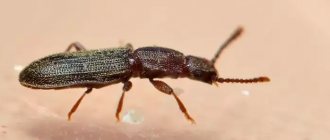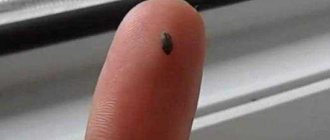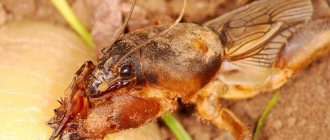There are many ways to fight moles. Some are designed only to catch animals, others are designed to immediately destroy them, and others are designed to ensure that the moles will leave the area on their own due to unfavorable conditions for them. We will tell you about the most effective methods.
A mole is an undeservedly offended creature. All sins are attributed to him that he did not commit. Root vegetables in the garden are gnawed - the mole is to blame! The roots of plants are gnawed - the work of a mole's hands (teeth)! The whole earth is up in arms - the mole has done a mischief again! But in reality, there is more than one mole operating in our gardens - there are several underground pest animals. And often it is they, and not the mole, who ruin our lives.
Who is causing us trouble and causing material damage? To understand this, you need to carefully study the traces of the “crime”. They will tell you who exactly came into our possessions.
What is the difference between a mole, a mole rat and a water vole?
At the summer cottage, three animals are engaged in underground “dirty tricks”: a mole, a mole rat and a water vole.
The water vole is better known as the water rat, or ground rat. Although in fact it is not a rat at all, but an animal of the Hamster family, because of their external similarity, the water vole is in everyday use called a rat. Often in the fall, during the preparation of supplies for the winter, this animal ends up in our gardens. That's when it starts to engage in sabotage. Root vegetables, tubers or plant bulbs that have been gnawed - the vole has worked with its teeth. If you notice that someone has gnawed the bark of seedlings or damaged the roots of trees, look for an earth rat in your possessions. Here and there mounds of earth appeared from underground passages - and here an earth rat could work.
The common mole rat is an animal from the order of rodents. Like the mole, the mole rat leads an underground lifestyle and, like the mole, has undeveloped eyes (hence the name of the animal). This is where the main similarities between the mole rat and the mole end.
The mole rat is a herbivorous animal. He happily eats plant roots, tubers and bulbs. It also loves above-ground parts: stems and leaves. The feeding passages of the mole rat are deeper than those of the mole - at a depth of 20-25 cm, while for the mole it is only 2-5 cm from the surface of the earth.
The mole, unlike the listed animals, does not feed on vegetation, because he is an insectivorous animal. Its main food is earthworms, so it is wrong to blame the gnawed crop on the mole. He is guilty only of spoiling the appearance of the lawn or area, and of touching the roots of plants while making moves. In other cases, you need to look for other culprits.
Shrew - features of the pest
The shrew is a small mammal, the length of which is no more than 50-70 mm, and the weight is up to 5-10 g. The animal has a small body with dense short fur, short legs, an elongated head with a long nose in the form of a proboscis.
The shrew lives in places with dense vegetation and soft soil (gardens, vegetable gardens, areas of private houses, etc.). Its diet is based on earthworms, wood lice, beetles and other insects. Due to its fast metabolism, the animal is constantly in search of food. When creating a system of passages, it harms plants and disrupts the normal structure of the soil.
Shrews in the garden are a sign of good moisture and a large number of insects in the soil.
Plastic bottles from Andrey Berezin
Andrey Berezin used the most famous method of fighting moles - a homemade “noise maker”. To make it, take any plastic bottle and cut 3-5 “windows” on its side surface. Bend the cut plastic to one side. Now all that remains is to attach the noise repeller.
To do this, take a metal rod, and in the bottom of the bottle make a hole with a slightly larger diameter than the diameter of the rod (due to this size, the bottle will not be statically fixed, but will be able to “dangle” freely on the pole, which will create additional sounds). Fix the container on the rod and stick it next to the moles’ habitat. To be safe, make several of these pinwheels and place them every 10-15 m throughout the area.
The wind will create noise, the metal pin will transmit it to the ground. Moles don’t like such a noisy life, so they go to quieter neighbors. As soon as you notice the appearance of new individuals, repeat the procedure.
You can also use this version of the “noise maker”, as in the photo. In this case, the noise is created by rotating blades that are loosely attached to the neck of the bottle.
Prevention
After the fight against moles is crowned with victory, it is worth thinking about protecting your possessions from repeated invasion.
- Alternatively, you can plant one of the above plants around the perimeter of the site, the smell of which repels moles;
- Summer residents, whose struggle has been difficult and exhausting, do not want to rely on chance and are taking radical measures - installing a protective barrier around the perimeter of their site. To do this, a trench is dug into which a fine-mesh metal mesh is installed in a vertical position and backfilled with earth. The mole will run into an obstacle and automatically change direction. True, you will have to dig quite deep. At least below the soil freezing level - 1.2-1.5 m, depending on the region. The general belief that moles sleep in winter is a misconception. It’s just that their activity decreases somewhat, and the depth of their passages becomes greater. Just imagine how labor-intensive this method is. And the metal, under the influence of moisture and minerals in the soil, will begin to corrode and collapse over time.
Therefore, if you notice molehills on your neighbors’ plots, immediately purchase and install commercial repellers at your dacha.
The article was written for the site.
Tags: Landscaping, Dacha
Using used cat litter to fight moles from Evgeniy Klyuev
In war, all means are good. Evgeniy Klyuev, for example, uses used cat litter (a good owner, as you know, never wastes anything, even used cat litter).
In a bucket of water, mix a lump of litter with cat waste. Fill the mole holes with the resulting solution, and then cover them with earth. Take a piece of reinforcement and use it to make many holes in the ground near the molehills. The animals will then move to a safe distance and stay away from your area.
What plants do moles not like?
There are a number of different plants that give off an odor that moles don't like. Animals will not put up with such a “scent” and will certainly leave the cellar. Here is a short list of them:
Fritillaria. It is also popularly called the imperial hazel grouse. This is a very pretty, beautifully flowering bulbous plant grown in gardens as an ornamental crop. Fritillaria exudes a sharp, mole-frightening odor, which is in many ways reminiscent of the odor emanating from a fox.
The bulbs of this plant should be laid out in the cellar in sufficient quantities so that the smell is clearly felt. Moles will begin to think that a predator is nearby and will leave the dangerous place.
Castor bean fruits . They are somewhat toxic to moles and emit an unpleasant odor. Castor beans must be specially grown in the garden, then in the fall the ripened fruits are collected, which are used for pouring into cellar stocks.
Ruthless fight against underground pests from Alexander Lisichkin
krot911.ru
Our reader Alexander Lisichkin decided to throw all his resources into the fight against moles. First, he suggests using noise repellers made from plastic bottles on poles. And for greater efficiency, at the same time, put dog excrement in the holes. If these methods are unsuccessful, you will have to move on to using traps.
There are two types of traps:
- Traps that kill animals.
- Live traps - in this case the mole will live. However, it is necessary to free the animal from the trap in time, because moles can survive without food for only 14 hours.
Alexander Lisichkin suggests building a live trap. To do this, take a plastic sewer pipe with a diameter of 50 mm. To make a trap, cut about half a meter of such pipe.
Now the entrances at both ends of the pipe need to be closed with “doors”. They can be made from the bottom and top of any tin can that is suitable in size. The height of the “door” should be approximately 5-6 mm larger than the hole, and the width, on the contrary, should be smaller.
Drill holes at the top, above the entrances, and secure the “doors” there with wire. Install them inside the pipe at a slight angle. Thanks to this trick, the mole will easily get inside the trap, but will not be able to get out of there: the “door” is larger than the hole, and the animal will not have enough strength to “open” it to the outside.
Dig up the mole passage and set a trap in the tunnel. The mole, walking through his labyrinths, should not suspect anything. Then he will calmly enter the pipe, but he will not be able to get out.
Using sound
Soil inhabitants (moles, mole crickets, mice, worms, etc.) are sensitive to the effects of impacts on the surface, which are transmitted deeper. To effectively scare away moles, summer residents often use simple ratchet structures. You will need:
- cuttings of metal water pipes longer than 80 cm;
- reinforcing rod or welding steel wire 0.7-1 cm thick;
- wooden plugs for the pipe, equal to its internal diameter;
- plastic mineral water bottles (hard and transparent) or 0.5 liter aluminum beer containers.
When installing such repellers, you need to know that the main mole tunnels run at a depth of at least 70 cm, and you will have to drive the pipe into the ground at approximately the same distance. It is better not to dig in the pipes, but to hammer them in with a sledgehammer, so as not to disturb the density of the soil and its ability to transmit sound.
The ratchet is made from a lightweight plastic or aluminum can:
- In the bottom of a PET bottle or the top of an aluminum container, a hole is made slightly larger than a rod. When rotating, the container should swing slightly, tapping the rod. The easiest way to burn a hole in a plastic bottle is with a soldering iron.
- Cut several “doors” on the sides and bend each flap outward. The doors should bend in one direction.
- Try the prepared ratchet on the rod. When using aluminum cans, you will have to push the central part of the bottom a little so that the can body can rotate. For a PET bottle, the pin fits comfortably into the neck (do not remove the cap).
- Insert a wooden plug into the hole of the driven pipe. Drive the pin into the wood and put a pinwheel from a bottle on top.
The design works even in low winds. The noise, which is almost inaudible to humans, is amplified by the pipe and transmitted into the soil, scaring off not only the mole, but also other soil inhabitants.
Ruthless mole hunting from Nikolai
Nikolai suggests immediately starting to fight moles tooth and nail. And he suggests starting with traps. Dig up several mole holes and set traps in them. After that, cover everything again with soil.
If you find a passage that goes at an angle deep into the earth, Nikolai suggests filling it. Pour in kerosene. Thanks to its very strong and unpleasant smell, it will force moles to leave their homes and go “for permanent residence” to another area.
In addition to the above, many of our readers who have freed their territories from moles recommend getting a rat-catcher cat or hunting dogs: dachshund, spaniel, terrier, etc. These animals will forever relieve you of the worries of fighting moles and other pests.
Have you ever had to fight moles on your property? And who won?
Preparations and devices for exterminating shrews
If folk remedies turn out to be ineffective, then traps, ultrasonic devices and chemical reagents are used to get rid of moles and shrews.
Traps
The following are used as traps:
- Hollow cylinders. A tunnel trap is a piece of pipe that is closed on both sides with tight flaps. The doors open inward freely, but block outward movement. Bait is placed in the trap and placed inside the active passage. You need to check the tunnel 3-4 times a day. Some devices have a built-in alarm that notifies you when an animal is caught.
- Wire mole traps. Metal traps are a system of a metal lever (clamp), a hook, an input ring, a spring and a guard. To cock the mole trap, you need to hook the clamp with a hook. When moving forward, the pest presses on the guard, and the lowered lever presses it in the input ring. Wire mole traps are installed in pairs, since the direction of travel is unknown.
- Traps. Mole traps of this type can resemble mousetraps or traps for small animals. They have a powerful spring, a lever and sharp jagged edges that injure the animal when trying to free itself.
When installing traps, you need to take into account that the main passages most often run along the perimeter of a fence, foundation, paths or other obstacles. The devices are installed underground through excavated holes. The top of the pit is covered with a layer of earth and turf.
Restraining devices are a fairly humane method of dealing with shrews. After catching it, it is enough to take it 0.8-1.5 km from the site.
Ultrasonic repellers
Ultrasonic repellers emit acoustic waves in a range that disorients rodents and small insectivores. When turned on, pests panic, lose coordination and try to leave the unsafe area as quickly as possible.
How to get rid of shrews on your property using ultrasound:
- position the repeller so that the entire area is within its range of action;
- stick a support into the ground;
- if necessary, connect the device to the electrical network;
- turn on the device (preferably in the evening or at night).
Repellers vary in range and type of power source. Powerful devices are connected to the network, and small ones have a built-in solar battery. In some cases, pests get used to the ultrasound frequency, so when choosing, you should pay attention to models that change the radiation range.
The following device models are most effective against shrews:
- Tornado 03;
- Grad 550 UZ;
- Antikrot;
- Thunder-plus;
- Ecosniper;
- Ecotek;
- Weitech WK-0675.
If there are small pets in the house (hamsters, rabbits, rats, etc.), it is better to avoid using ultrasonic repellers.
Chemicals
The most effective remedies for moles and shrews are:
- Mole Meter G. The product has a low danger, since its main component is garlic extract. When placed in burrows it has a repellent effect. To drive away pests, you need to bury odorous granules in holes or vertical cuts near holes and central passages. The consumption rate is 5-7 g for each hole. For prevention, the drug is laid out around the perimeter of the fence.
- STOP-Mole. The drug is available in the form of tablets that quickly evaporate, turning into a poisonous gas. The chemical fills numerous passages, driving out the shrew. To fill evenly, place 2-3 tablets in each hole. You need to lay out the drug with gloves and only in dry weather.
- Nutcracker. It is a thick dough-like bait, which is laid out near the main habitats. The consumption rate of the drug is 1 packet for every 20 m. The death of pests occurs after 3-4 days.
- Rat death. An inexpensive product that is poured into passages and holes. One package is enough to treat an area of 8-10 acres. After eating the bait, the animal dies within 4-8 days.
- Hunter. Available in the form of granules that contain poison and bait. The drug is poured into holes or applied to the top layer of soil at the rate of 10-30 g per 1 sq.m. The death of the pest occurs within a week.
It is best to destroy moles and shrews with chemicals in calm, dry weather and in the absence of domestic animals. If baits are swallowed by pets, contact your veterinarian immediately.
Ready-made products
Ultrasound devices
These are electronic repellers that create high-frequency vibrations. Examples include “Tornado”, “Electrocat”, “Antikrot”, “Typhoon”. You will need a model for open areas. Devices designed for indoor use will not be suitable.
A person does not hear ultrasound. It causes panic in animals, so the device is unlikely to be suitable for owners of cats and dogs.
The body resembles a nail with a pointed leg inserted into the ground and a head. Models differ in power and power supply method. The coverage area and the strength of the impact depend on the power. The louder the sound, the better. The devices are powered by mains and battery. There are repellers that change frequency so that pests do not have time to get used to the wave effect. It will be possible to achieve the desired effect only after a few days.
Mousetraps and traps
They are designed specifically for rodents. Cats and dogs will not get caught in them. Traps are immersed in a hole or placed throughout the territory. Insects and earthworms serve as bait.
Using sound
Soil inhabitants (moles, mole crickets, mice, worms, etc.) are sensitive to the effects of impacts on the surface, which are transmitted deeper. To effectively scare away moles, summer residents often use simple ratchet structures. You will need:
- cuttings of metal water pipes longer than 80 cm;
- reinforcing rod or welding steel wire 0.7-1 cm thick;
- wooden plugs for the pipe, equal to its internal diameter;
- plastic mineral water bottles (hard and transparent) or 0.5 liter aluminum beer containers.
When installing such repellers, you need to know that the main mole tunnels run at a depth of at least 70 cm, and you will have to drive the pipe into the ground at approximately the same distance. It is better not to dig in the pipes, but to hammer them in with a sledgehammer, so as not to disturb the density of the soil and its ability to transmit sound.
The ratchet is made from a lightweight plastic or aluminum can:
- In the bottom of a PET bottle or the top of an aluminum container, a hole is made slightly larger than a rod. When rotating, the container should swing slightly, tapping the rod. The easiest way to burn a hole in a plastic bottle is with a soldering iron.
- Cut several “doors” on the sides and bend each flap outward. The doors should bend in one direction.
- Try the prepared ratchet on the rod. When using aluminum cans, you will have to push the central part of the bottom a little so that the can body can rotate. For a PET bottle, the pin fits comfortably into the neck (do not remove the cap).
- Insert a wooden plug into the hole of the driven pipe. Drive the pin into the wood and put a pinwheel from a bottle on top.
The design works even in low winds. The noise, which is almost inaudible to humans, is amplified by the pipe and transmitted into the soil, scaring off not only the mole, but also other soil inhabitants.
A good cat is the head of everything
A pet is the ideal solution to the problem of how to drive away a mole. A cat, a dog, or a couple of pets will harass all the shrews, as well as rats and mice. The stomping of paws creates vibration, the sound of barking and meowing creates noise, and marks create smell. A triple blow to the psyche and nerves of pests bears fruit in 1-2 seasons.
The problem is different - not every spoiled city cat will start hunting pests. Some cats and dogs are themselves afraid of rats and mice. The solution is to accustom your baby to hunting with regular trips to the country or feed the local “Vaska”. In the summer season, the areas are full of stray cats; they will take out all the unnecessary “guests” for a bowl of milk.
When thinking about how to drive moles out of your dacha, do not forget that cats can also cause considerable harm to plants, especially young seedlings. Pets are also taught not to eat moles, mice, or rats, so as not to get poisoned.











